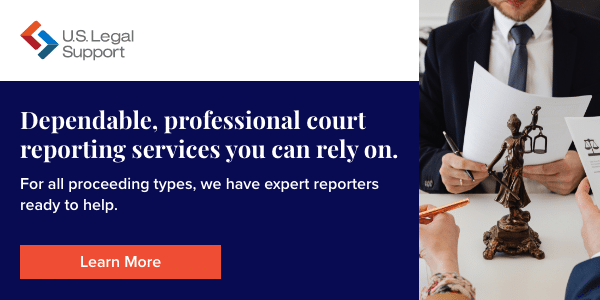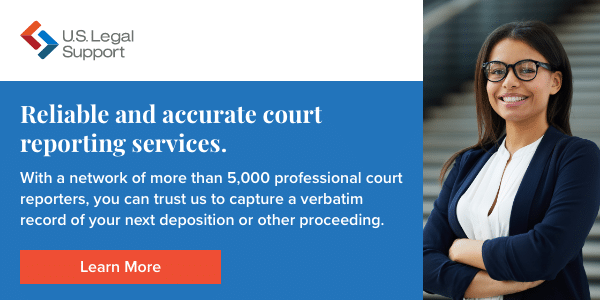How to Become a Legal Transcriptionist

If you’re in the market for flexible, at-home work that provides variety and lucrative pay with expedited training, legal transcription should be on your shortlist.
Transcriptionists play a key role in the legal industry, turning spoken words into text files that can be used for legal proceedings, entered as evidence, general meeting recordings, and much more.
Today, we’ll discuss how to become a legal transcriptionist and what this profession can offer you.
What Is Legal Transcription?
Transcription is the process of capturing spoken language—either live or recorded—and converting it to a written format.
The use of transcription services for legal purposes is where the process first began. Ancient civilizations in China and Greece recognized the need to create a permanent record of legal proceedings. They developed methods of shorthand to help scribes capture speech as quickly as it was spoken.
Today, transcription can be separated from the act of capturing speech via shorthand at a live event. Instead, transcription relies on an audio or video recording that can be stopped and started while you type in the words and sounds that you hear.
In addition to the legal industry, it’s a common business practice for many industries such as:
- Medical
- Academic
- Real estate
- Energy
- Finance and banking
- Insurance
Verbatim Legal Transcription
While accuracy is important for all of these environments, legal transcription emphasizes the creation of an exact record that includes every utterance and sound. This means that a legal transcript often displays:
- Stuttering
- False starts, interruptions, and trailing sentences
- Coughs, laughter, or crying
- Relevant environmental sounds
Though the goal is a verbatim transcript that reflects every word and sound, the finished product may also include a notation that something was unintelligible. Since legal transcriptionists review recordings rather than attend live events, they can’t ask a speaker to repeat their words more clearly.
Content of Legal Transcriptions
It’s not all courtroom drama. A legal transcript may be a record of:
- Trials, arraignments, sentencings, and other court proceedings
- Official memos and correspondence
- Depositions
- Emergency or 911 calls
- Interrogations
- A formal business or organizational meeting that adheres to bylaws
What Does a Legal Transcriptionist Do?
On a typical workday, a legal transcriptionist may complete one court transcription or other job, or more, depending on their speed. After accepting a legal transcription job, they will usually:
- Take receipt of the audio file
- Set up a template based on the type of proceeding or information recorded
- Open the file in the software that connects it to their peripherals
- Listen to the recording while using a foot pedal to play, stop, and rewind as needed
- Type every spoken word and non-verbal sound to create a verbatim transcript
- Review punctuation and complete a spelling and grammar check
- Send the file to the client or partner they work with
Duties of a Legal Transcriptionist
Unlike a court reporter, legal transcriptionists typically work from audio and video recordings to generate a text record. However, they may provide additional support depending on the position or assignment. Roles and duties can extend to:
- Proofreading and organizing
- Reviewing and revising transcripts
- Transcribing dictation to capture notes, plans, or memoirs
Work Flexibility of a Legal Transcriptionist
Most legal transcriptionists work as independent contractors or through general transcription or court reporting agencies. As such, they may control:
- Which assignments they accept
- Their working hours and breaks
- How much they earn
How to Become a Legal Transcriptionist
Many legal transcriptionists start as trained Stenographers, but it’s also possible to enter the field as a newcomer. You can begin legal transcribing with just a high school diploma and some on-the-job training, though you may achieve higher pay and a wider range of jobs to pick from if you opt for formal training and certification.
Step 1: Develop Your Skills
Are you suited for a job in legal transcription? Helpful skills and traits include:
- Fast and accurate typing—at least 75 words per minute with few to no errors1
- Ability to work independently and meet deadlines
- Excellent attention to detail
- Strong spelling, grammar, and syntax
- Excellent hearing and listening skills
Boosting your skill set will help you enter a career in legal transcription and increase your income as a legal professional and transcriptionist in the legal field. To do this, you can:
- Practice your typing to increase speed and accuracy
- Play recordings and practice transcribing them to improve listening comprehension
- Take classes on project organization, time management, or proofreading
- Review completed verbatim transcripts to familiarize yourself with formatting
Step 2: Complete the Necessary Training
There’s a wide range of skills and educational backgrounds across legal transcriptionists. If you’re in a position that allows you to learn on the job, you’ll generally need just a high school diploma, basic computer skills, and some office or administrative experience to get started.
However, while it doesn’t require a specific degree or certificate program, legal transcription training will fully equip you to enter the profession. These programs:
- Typically range from $99 to $5,000 in cost2
- Usually take three to six months to complete
- Are available from vocational schools, community colleges, or online providers
The training for legal transcriptionist jobs typically covers:
- Legal system basics
- Ethics
- Career options
- Using transcription software and devices
- Legal terminology, abbreviations, and other style expectations
- Transcript formatting and templates
- Best practices for typing faster and more accurately
- Proofreading and research
Step 3: Acquire a Certification
Certification can take your resume and career to a more professional level, so let’s take a look at how to become a certified legal transcriptionist.
The American Association of Electronic Reporters and Transcribers (AAERT) certifies legal transcriptionists. To achieve this goal, you’ll need to pass the Certified Electronic Transcriber (CET) exam, comprised of a written multiple-choice test and a practical examination.1
After you’re initially certified, you’ll need to complete three continuing-education credits and renew with AAERT every three years to maintain your CET designation.3
Some agencies, court systems, and government contracts require AAERT certification, so it’s a wise idea to become certified if you’re serious about pursuing legal transcription work.4
Setting Up Your Legal Transcription Work Space
If you work independently rather than for an employer who provides it, you’ll need to purchase transcription equipment to use at home. This may cost anywhere from $200 to $1,000, and require equipment such as:
- A USB foot-pedal with play, rewind, and fast-forward controls2
- One or more types of software to play back the audio file in connection with the pedal
- Transcription-specific headphones
- Microsoft Word or equivalent software
You’ll also most likely want a:
- Relatively current computer with adequate storage
- High-speed internet connection
- Ergonomic desk, chair, and keyboard
Earning Potential for Legal Transcribers
According to the Bureau of Labor Statistics, a 9% increase in most types of legal transcription jobs over the next decade is expected, almost double the overall job growth rate.1
Since a large population of legal transcriptionists works independently, government figures may underestimate the earning potential of a motivated high-speed transcriptionist. On average, legal transcriptionists earn:
- $66,710 nationwide average
- $43,730 for early-career professionals
- $109,240 for experienced professionals
Advancing Your Career as a Legal Transcriptionist
Freelancers are typically paid based on their output rather than hours. Typing speed, listening and comprehension skills, and familiarity with the process, templates, and jargon can all affect your earning potential.
While you can expect to improve your skills over time, you can also dedicate time or take courses to boost your speed and competency.
Other ways to advance in a legal transcriptionist career include:
- Increase your networking and online testimonials
- Market yourself through LinkedIn or a professional website
- Work with an agency with extensive opportunities and worker support
Other Roles for Legal Transcribers
Legal transcription can be a jumping-off point or a career flex from a different profession, and it can also overlap with other roles. In addition to dedicated legal transcriptionists, this type of work is often completed by:
- Court reporters
- Stenographers, voice writers, and real-time transcriptionists
- Paralegals and legal assistants, secretaries, and administrators
What often sets legal transcription apart when approached as a dedicated role is the independence, flexibility, and informal environment. You can easily work from home as an independent contractor and take on assignments that fit your schedule and preferences.
See related: Legal Transcriptionist vs. Court Reporter
What’s the Difference Between a Legal Transcriptionist and a Stenographer?
In actuality, most legal transcriptionists working today are also trained Stenographers, which requires an associate’s degree program in stenography or a court reporting program.
Transcription is built into the stenography process, which starts from capturing a record of speech during a live proceeding in shorthand via a stenograph machine. From that point, the stenotype input is converted to written text via computer-aided transcription (CAT) software, with a final review after the event to ensure accuracy before the official transcript is delivered.
Legal transcriptionists, on the other hand, don’t need to learn shorthand, how to use a stenograph machine, or how to participate in a live legal proceeding, as they typically transcribe from an audio recording.
Find a Transcriptionist or Join Our Team of Trained Legal Transcriptionists
Looking for legal transcriptionist jobs? U.S. Legal Support partners with a nationwide network of 5,000+ experienced transcriptionists and court reporters.
Ready to learn more about our legal support services? Reach out today to connect with us.
Sources:
- ParaLegalEDU.org. Legal Transcriptionist: What it is & How to Become One. https://www.paralegaledu.org/blog/legal-transcriptionist/
- Learn Legal Transcription. How Much Does it Cost to Become a Legal Transcriber? https://www.learnlegaltranscription.com/how-much-does-it-cost-to-become-a-legal-transcriber/
- Indeed. How To Become Legal Transcriptionist. https://www.indeed.com/career-advice/finding-a-job/how-to-become-legal-transcriptionist
- ed2go. Legal Transcriptionist. https://www.ed2go.com/courses/legal/legal-studies/ctp/legal-transcriptionist

Editoral Policy
Content published on the U.S. Legal Support blog is reviewed by professionals in the legal and litigation support services field to help ensure accurate information. The information provided in this blog is for informational purposes only and should not be construed as legal advice for attorneys or clients.



